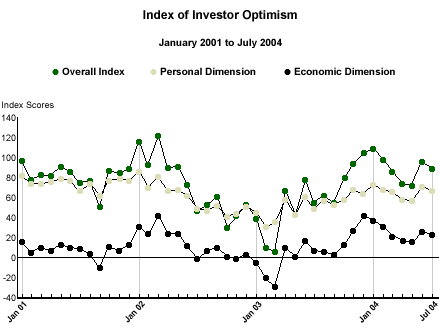Investor optimism dipped in July, according to the UBS/Gallup Index of Investor Optimism survey*. There are several possible explanations for this decline -- ranging from the high price of gas and the softening of consumer spending to the situation in Iraq and the presidential election -- but one recent source of investor concern is clear: fear of higher interest rates. Six in 10 investors expect rates to increase over the next three months, while two-thirds oppose higher rates and most think higher interest rates will hurt the economy.
While the Federal Reserve Board seems to significantly discount these fears, Gallup's data suggest that the risks associated with higher rates may be greater than many suspect. The rapid growth of home equity loans that helped fund consumer spending during the historically low interest rate period will likely have just the reverse effect as interest rates go up.
Investor Optimism Dips
The Index of Investor Optimism fell seven points to 88 in July, bringing it close to its March level (85) but below that of January (108), February (97), and June (95). However, the Index remains well above its April (73) and May (71) levels.
The Personal Dimension of the Index, which measures investors' views of their personal financial situations, decreased four points to 66 in July, essentially matching its February (67) and March (65) levels. The Economic Dimension, which measures investors' overall economic outlook, decreased three points to 22 in July -- down from 25 in June, but well above where it was in April (16) and May (15).

The Fed's Position
Last week, Fed Chairman Alan Greenspan delivered his semiannual Monetary Policy Report to the Congress. During his testimony, he reassured Congress about consumer spending and retail sales: "Those higher [energy] prices, by eroding households' disposable income, have accounted for at least some of the observed softness in consumer spending of late, a softness which should prove short-lived." He went on to say: "Despite the softness of recent retail sales, the combination of higher current and anticipated future income, strengthened balance sheets, and still-low interest rates bodes well for consumer spending."
I agree with this analysis of consumer spending, as I projected it several weeks ago -- but I'd also note that the "softness" of consumer spending may not be as "short-lived" as the Fed suggests if gas prices remain at today's high levels.
More importantly, I would take issue with another assertion made in the Greenspan testimony: "Lastly, very large fractions of total outstanding obligations of businesses and households are long-term, fixed-rate debt. As a result, rising market interest rates will not have much immediate direct effect on business and household debt service burdens."
The Potential Impact of Adjustable Debt
It's true that many Americans have taken advantage of the historically low interest rates of recent years to refinance their debt at relatively low long-term interest rates. However, this poll suggests that investors hold a great deal more adjustable debt than many people seem to believe.
Fixed-rate loans dominate the first mortgage home-loan market, with 87% of investors with mortgages saying they have fixed-rate mortgages and only 13% with adjustable mortgages. In addition, most variable-rate first mortgages have a variety of protections built in that protect the consumer from sharp interest rate increases and the associated dramatic rise in monthly payments.
Although credit card holders tend not to enjoy the same interest rate protections, investors with credit cards report that only about 20% of their credit cards have adjustable interest rates. While rate increases can create significant problems for consumers with large credit card balances, they may be a manageable problem from an overall economic perspective.
However, home equity loans are a real concern. Roughly one in four investors have home equity loans, and 42% of them report having an adjustable loan. These adjustable loans rarely have any consumer interest rate or payment protections, leaving many consumers open to significant interest rate and payment risk.

Bottom Line
In my view, the growth of variable-rate debt during the past few years of "easy money" has been much greater than generally perceived. This survey shows that a significant percentage of investors are highly exposed to higher interest rates. This self-reported data may even understate the holdings of variable-rate home equity loans, since some loan combinations are so complex that many borrowers may not fully understand their adjustable nature.
The Fed may dismiss the group of Americans vulnerable to interest rate increases as too small to impact the overall economy. On the other hand, the Fed has often noted that the rapid growth of home equity borrowing has helped fuel consumer spending over the past several years. If their growth was significant enough to increase consumer spending in the past, logic suggests that an increase in the interest rates and payments for more than 40% of home equity loan holders can have a significant impact in the opposite direction.
*Results for the Index of Investor Optimism -- U.S. are based on telephone interviews with a randomly selected U.S. sample of 802 adult investors, aged 18 and older, with at least $10,000 of investable assets, conducted July 1-18, 2004. For results based on this sample, one can say with 95% confidence that the maximum error attributable to sampling and other random effects is ±4 percentage points. In addition to sampling error, question wording and practical difficulties in conducting surveys can introduce error or bias into the findings of public opinion polls.

